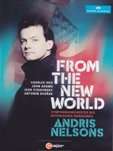|
Back
01/27/2014
“From the New World”
Charles Ives: The Unanswered Question
John Adams: Slonimsky’s Earbox
Igor Stravinsky: Le Chant du rossignol
Antonín Dvorák: Symphony No. 9 in E Minor, Op. 95 “From the New World”
Symphonieorchester des Bayrischen Rundfunks, Andris Nelsons (conductor)
Recorded at the Herkulessaal of the Munich Residence (December 3-4, 2010) – 95’
C Major 713408 (or Blu-Ray 713504) – Picture Format: 16:9 NTSC Full HD – Sound Format: PCM Stereo, DTS 5.0 – Booklet essays in English, German, and French

   
In the USA, the hype surrounding Andris Nelsons is his appointment as Music Director of the Boston Symphony Orchestra. Here, conducting one of the great German ensembles in a rousing, varied program, Nelsons’ energy on the podium, most contagious in the two middle works, is complemented by a cool reserve in the Ives and a personal, idiosyncratic reading of the Dvorák. The intelligent program, excellent orchestral playing and smart video integration make this video a wonderful introduction to a rising podium figure.
The program begins in the foyer of Munich’s functional Herkulessaal, the strings of the orchestra intoning Ives’ transcendent chorale. The questioning trumpeter is never visible, but the answering flautists play from the stage of the hall. The shifts in perspective in this piece alone are distracting from the underlying stasis of the piece, but the performance is a fine one, the flute quartet especially delighting in its variegated responses.
John Adams writes that his Slonimsky’s Earbox was modeled after “the exploding first few moments of Stravinsky’s symphonic poem, Le Chant du rossignol and hearing the pieces juxtaposed is fascinating. Adams' piece is a miniature concerto for orchestra, traversing through virtuosic solo passages that are picked up en masse by each principal’s respective sections, all of this happening over an unpredictable beat, with heavy doses of jazz and American pop music. The piece often explodes in flamboyant bursts of orchestral color, and Nelsons’ players relish their chances to shine. The videography here complements the piece more readily, jumping from player to player as motives are bandied about. It’s a thrilling dozen or so minutes of playing.
Stravinsky’s Nightingale tone poem is equally riotous, although viewed through the haze of the Ballets Russes instead of American dance music. The score ranges in mood and color even more than the Adams piece, the whole affair expertly bringing to mind Hans Christian Andersen’s fairytale world. The famous solo flute and oboe passages are expertly dashed off, while brass fanfares, bassoon grunts, string soli and celesta roulades are woven in and out of the fabric, all held in perfect check and balance by Nelsons. The energy and exuberance of the Adams and Stravinsky leave Nelsons looking like he’s just ran a marathon, but he is all smiles throughout.
In the Dvorák symphony, Nelsons' interpretation becomes more idiosyncratic. In the first movement, he insists on a syrupy legato that robs certain moments of their forward momentum. The delight in extreme dynamic contrasts—the opening chorale played as if the strings have returned to the foyer—helps counterbalance this. The "Largo" is more suited to Nelsons’ stance, and the cor anglais solo is given a nicely straightforward rendition. Dvorak’s rhythmic games in the "Scherzo" see Nelsons return to the athletic gestures of the Adams, and the videographers here seem quite won over by the timpanist’s energetic playing. The finale has a speedy main tempo, but still sees Nelsons pushing and pulling at odd moments, and the syrupy legato returns when the strings take over the main theme. As the orchestra is pushed into overdrive as the work concludes, Nelsons adopts a strange approach of grimacing or growling on the podium, no longer indicating a beat. It seems a bit put on, but one can’t argue with the energetic results that he gets from the players. The final heartbeats of the timpani that usher in the coda are dragged out quite a deal, almost as if in the middle of one of Mahler’s more tragic movements, and appreciation must be given the final woodwind chord, which is given a lengthy fermata but remains perfectly in tune.
Overall, then, a solid program, especially fine in the first three works and featuring a finely played but interpretively mannered reading of the Dvorák symphony. It will be interesting to follow Nelsons' career in the “new world.”
Marcus Karl Maroney
|